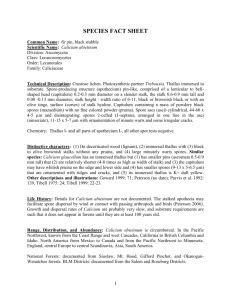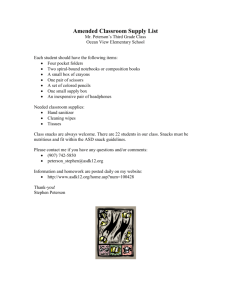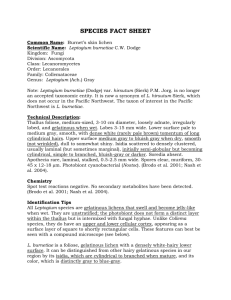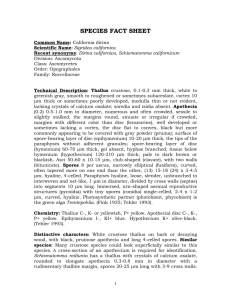SPECIES FACT SHEET
advertisement
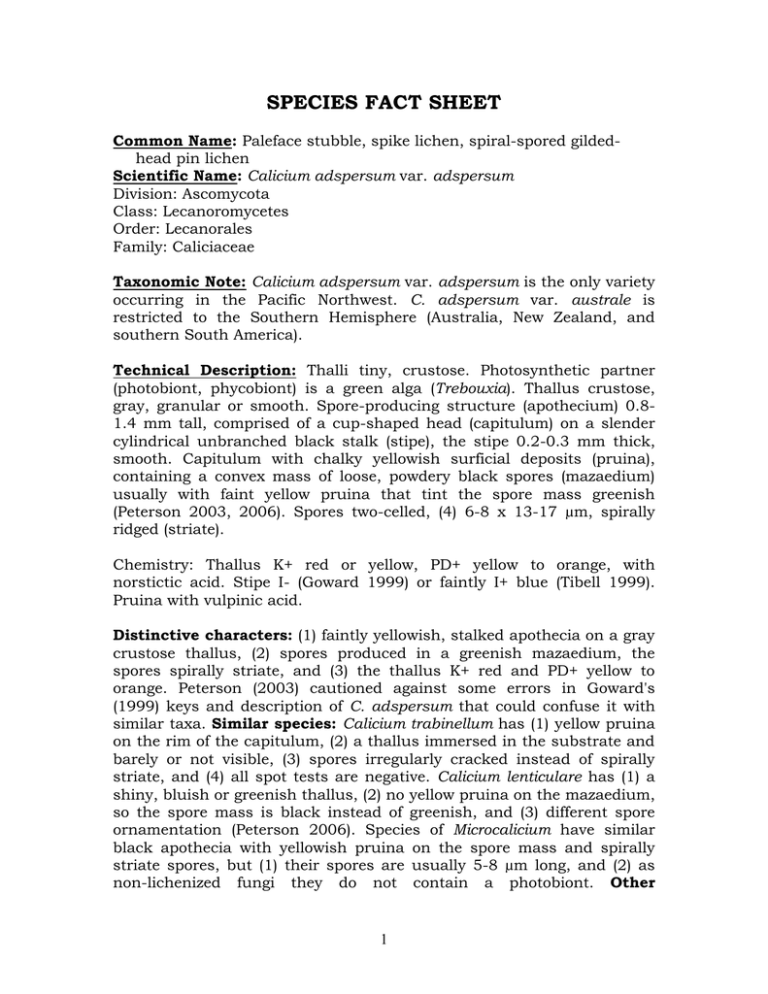
SPECIES FACT SHEET Common Name: Paleface stubble, spike lichen, spiral-spored gildedhead pin lichen Scientific Name: Calicium adspersum var. adspersum Division: Ascomycota Class: Lecanoromycetes Order: Lecanorales Family: Caliciaceae Taxonomic Note: Calicium adspersum var. adspersum is the only variety occurring in the Pacific Northwest. C. adspersum var. australe is restricted to the Southern Hemisphere (Australia, New Zealand, and southern South America). Technical Description: Thalli tiny, crustose. Photosynthetic partner (photobiont, phycobiont) is a green alga (Trebouxia). Thallus crustose, gray, granular or smooth. Spore-producing structure (apothecium) 0.81.4 mm tall, comprised of a cup-shaped head (capitulum) on a slender cylindrical unbranched black stalk (stipe), the stipe 0.2-0.3 mm thick, smooth. Capitulum with chalky yellowish surficial deposits (pruina), containing a convex mass of loose, powdery black spores (mazaedium) usually with faint yellow pruina that tint the spore mass greenish (Peterson 2003, 2006). Spores two-celled, (4) 6-8 x 13-17 µm, spirally ridged (striate). Chemistry: Thallus K+ red or yellow, PD+ yellow to orange, with norstictic acid. Stipe I- (Goward 1999) or faintly I+ blue (Tibell 1999). Pruina with vulpinic acid. Distinctive characters: (1) faintly yellowish, stalked apothecia on a gray crustose thallus, (2) spores produced in a greenish mazaedium, the spores spirally striate, and (3) the thallus K+ red and PD+ yellow to orange. Peterson (2003) cautioned against some errors in Goward's (1999) keys and description of C. adspersum that could confuse it with similar taxa. Similar species: Calicium trabinellum has (1) yellow pruina on the rim of the capitulum, (2) a thallus immersed in the substrate and barely or not visible, (3) spores irregularly cracked instead of spirally striate, and (4) all spot tests are negative. Calicium lenticulare has (1) a shiny, bluish or greenish thallus, (2) no yellow pruina on the mazaedium, so the spore mass is black instead of greenish, and (3) different spore ornamentation (Peterson 2006). Species of Microcalicium have similar black apothecia with yellowish pruina on the spore mass and spirally striate spores, but (1) their spores are usually 5-8 µm long, and (2) as non-lichenized fungi they do not contain a photobiont. Other 1 descriptions and illustrations: Brodo et al. 2001: 193; Goward 1999: 73; Tibell 1999: 23; Mikulin (no date); Peterson 2003; Peterson (no date). Life History: Details for Calicium adspersum are not documented. The stalked apothecia may facilitate spore dispersal by wind or contact with passing arthropods and birds (Peterson 2006). Growth and dispersal rates of Calicium are probably very slow, and substrate requirements are such that it does not appear in forests until they are at least 100 years old (Peterson 2003). For this reason it has been documented as an indicator of forest age and continuity (e.g., Selva 1996). Range, Distribution, and Abundance: Calicium adspersum var. adspersum is interruptedly circumboreal. In the Pacific Northwest, known from British Columbia south to California. In Oregon it has been found at Little Sink RNA in the Salem BLM District and in the McDonaldDunn Research Forest north of Corvallis. In Washington it has been found at Bald Hill Natural Area Preserve in Thurston County. Reports from Arizona and Mexico were questioned by Peterson (2003, 2006) because of a presumed lack of habitat and absence from recent regional floras. Found in Scandinavia, UK, Europe, and eastern North America. C. adspersum var. australe is restricted to the Southern Hemisphere (Australia, New Zealand, and southern South America). National Forests: none documented; BLM Districts: documented from the Salem District. Widespread globally undercollected. but rare in parts of its range, probably Habitat: Forming small crusts on bark of living Abies grandis, Pseudotsuga menziesii, Quercus sp., Sequoia sempervirens and Thuja plicata at or below 2,000 feet elevation (Goward 1999; Peterson 2003, 2006; Rikkinen 2003). In the Pacific Northwest, all known occurrences are on trees older than 200 years (Peterson and McCune 2000; Peterson 2003, 2006). It usually occurs in relatively open stands in drier microhabitats where sheltered from precipitation, such as in crevices of bark, the dry side of leaning trunks, or the underside of limbs. Forest types are Abies grandis, Tsuga heterophylla, Pseudotsuga menziesii, and Sequoia sempervirens associations. In other parts of its range it occurs on oak, spruce, and decorticated wood. Threats: Pervasive logging of old-growth forests in North America and Europe has diminished habitat and opportunities for dispersal of Calicium adspersum, but there is evidence that it can survive some forest 2 fragmentation (Peterson 2003). Altered fire frequency and intensity resulting from fire suppression and fuel buildup may threaten remaining populations (Peterson 2006). Conservation Considerations: On federal lands, consider revisiting all known localities and monitoring the status of populations (currently only known from one federal site). Search for new populations on federal lands. Protection of known sites from logging, road and trail work, and scorching of tree trunks during prescribed fire will help minimize risk to populations. Manage understory in known sites to maintain open conditions. Conservation rankings: Global: G3G4, G4 recommended by Peterson (2006); National: NNR. Oregon Natural Heritage Information Center: List 2 (S1). Recommended for listing in California (Peterson 2006). Considered rare in several European countries. Preparer: John A. Christy, with edits from Daphne Stone. Date Completed: December 2007; updated March 2009 Attachment 2 (Map of Oregon and Washington locations). with addition of ATTACHMENTS: (1) (2) List of References Map of locations of Calicium adspersum var. adspersum in Oregon and Washington Attachment 1 – List of References Links are provided below to guide you to additional information that be helpful in understanding this species. Included are links to illustrations, photographs, maps and ranking information used to determine threats and status by State Heritage Programs. Brodo, I. M., S. D. Sharnoff and S. Sharnoff. 2001. Lichens of North America. Yale University Press, New Haven and London. 795 pp. Goward, T. 1999. The lichens of British Columbia. Part 2. Fruticose species. British Columbia Ministry of Forests. 319 pp. Middelborg, J. 2005. The lichen order Caliciales. http://www.thavibu.com/caliciales/index.htm 3 Mikulin, A. (no date). Illustration of Calicium adspersum. USDA Forest Service National Lichens and Air Quality Database and Clearinghouse. http://gis.nacse.org/lichenair/index.php?page=illustrations Oregon Natural Heritage Information Center. 2007. Rare, threatened and endangered species of Oregon. Oregon Natural Heritage Information Center, Oregon State University. Portland. 100 pp. http://oregonstate.edu/ornhic/2007_t&e_book.pdf Peterson, E.B. (no date). Photograph of Calicium adspersum. USDA Forest Service National Lichens and Air Quality Database and Clearinghouse. http://gis.nacse.org/lichenair/index.php?page=photos _______. 2003. Heritage rank status factors for Calicium adspersum: global, California, Oregon, Washington. http://oregonstate.edu/ornhic/survey_manage_ranks.html _______. 2006. Calicium adspersum, sponsorship for the CALS conservation committee. The Bulletin of the California Lichen Society 13: 51-54. http://calscc.crustose.net/sponsorships/Calicium_adspersum.pdf _______ & McCune, B. 2000. Environmental relations of calicioid lichens and fungi in a temperate landscape. In: Peterson, E. B. Analysis and prediction of patterns in lichen communities over the western Oregon landscape. Ph.D. dissertation, Oregon State University, Corvallis. _______ & Rikkinen, J. 1999. Range extensions of selected pin-lichens and allied fungi in the Pacific Northwest. Bryologist 102: 370-376. Rikkinin, J. 2003. Calicioid lichens and fungi in the forests and woodlands of western Oregon. Acta Botanica Fennica 175: 1-41. Selva, S. B. 1996. Using lichens to assess ecological continuity in northeastern forests. Pp. 35-48 in: M. B. Davis (ed.), Eastern oldgrowth forests: prospects for rediscovery and recovery. Island Press, Washington, D. C. 399 pp. Tibell, L. 1975. The Caliciales of boreal North America. Symbolae Botanicae Upsalienses 21(2): 1-128. _______. 1999. Nordic Lichen Flora. Volume 1. Calicioid lichens and fungi, pp. 20-93. The Nordic Lichen Society, Uddevalla, Sweden. 94 pp. 4 Attachment 2 - Map of locations of Calicium adspersum var. adspersum in Oregon and Washington 5
